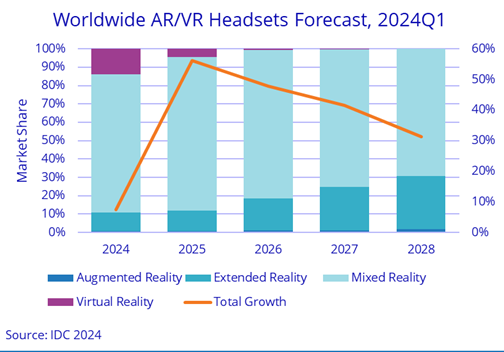- Meta dominates market in first quarter, followed by Apple, ByteDance, Xreal and HTC.
- IDC forecasts a return to growth in headset shipments later this year, with a projected 7.5% increase over 2023.
- Beyond 2024, the shipment volume is forecast to see an annual growth rate of 43.9% from 2024 to 2028, indicating a promising future for the industry.
The global shipments of augmented reality and virtual reality (AR/VR) headsets have experienced a significant decline in the first quarter of 2024, dropping 67.4 per cent year-over-year.
The decline was expected as the market transitions to incorporate new categories such as Mixed Reality (MR) and Extended Reality (ER). The International Data Corporation (IDC) recently revised its taxonomy to include these new categories, reflecting the evolving nature of the industry.
Despite the declining shipments, the average selling price (ASP) of these headsets has risen to over $1,000, largely due to the entry of Apple into the market and the focus of incumbents, such as Meta, on premium offerings like the Quest 3.
The price increase can be attributed to the ongoing innovation and development in the field, as manufacturers seek to provide users with more immersive and advanced experiences.
The market leadership in the first quarter of 2024 was dominated by Meta, followed by Apple’s recent entry. ByteDance, Xreal, and HTC rounded out the top 5 players.

The introduction of the Quest 3 and the Vision Pro has helped to educate users and encourage developers to create mixed reality content, blending the digital and physical worlds. However, this technological advancement has come at a premium for consumers.
Lower price points
Looking ahead, IDC forecasts a return to growth in headset shipments later this year, with a projected 7.5% increase over 2023.
“With mixed reality on the rise, expect strictly virtual reality headsets to fade in the coming years as brands and developers devise new hardware and experiences to help users eventually transition to augmented reality further down the line,” Jitesh Ubrani, research manager, Worldwide Mobile Device Trackers at IDC, said.
The introduction of newer headsets and lower price points are expected to drive this turnaround. Beyond 2024, the headset shipment volume is forecasted to see a compound annual growth rate (CAGR) of 43.9% from 2024 to 2028, indicating a promising future for the industry.
The decline in strictly virtual reality headsets is expected, as the market shifts towards mixed reality and extended reality solutions. These new categories offer users a more seamless integration of the digital and physical worlds, providing a more immersive and engaging experience.
As the technology continues to evolve, the industry can expect to see a gradual transition towards augmented reality as the primary focus for future developments.
